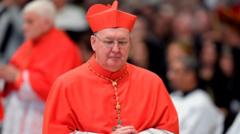
Cardinal Assumes Governance of Vatican City During Sede Vacante
VATICAN CITY – Following the passing of the Supreme Pontiff, the governance of Vatican City State has officially transitioned to the designated Cardinal Camerlengo. This period, known as the sede vacante (vacant see), marks a time of both mourning and procedural transition within the Catholic Church. The Cardinal will hold the administrative reins until a new Pope is elected by the College of Cardinals.
The Role of the Cardinal Camerlengo
The Camerlengo, whose identity is kept closely guarded until the moment of the Pope's death is officially announced, bears a significant responsibility during the interregnum. This cardinal is tasked with overseeing the day-to-day operations of the Vatican and ensuring the continuity of essential functions. His duties are multifaceted and critical to the smooth functioning of the Church during this sensitive period.
Key Responsibilities Include:
- Officially confirming the passing of the Pope. Traditionally, this involved a symbolic act using a silver hammer, though this practice has evolved in recent times.
- Affixing seals to the Papal apartments and offices. This measure safeguards against any unauthorized access or tampering with documents and property.
- Notifying the Cardinal Vicar of Rome and the diplomatic corps accredited to the Holy See. These notifications formally inform key parties of the Pope's death and the commencement of the sede vacante.
- Communicating with the Cardinal electors, summoning them to Rome for the Papal conclave. This crucial step initiates the process of electing a new Pope.
- Presiding over the initial meetings of the College of Cardinals to discuss logistical arrangements for the conclave. This includes matters such as security, accommodation, and voting procedures.
The Papal Conclave: Electing a New Pontiff
The heart of the sede vacante period is the Papal conclave, a gathering of the Cardinal electors within the confines of the Sistine Chapel. These cardinals, all under the age of 80, are sequestered from the outside world and charged with the solemn duty of electing a successor to Saint Peter. The process is shrouded in secrecy and governed by strict rules to ensure a free and uninfluenced vote.
Conclave Procedures: A Detailed Overview
- The Oath of Secrecy: Upon entering the Sistine Chapel, each cardinal elector takes an oath of secrecy, pledging to maintain absolute confidentiality regarding the proceedings of the conclave.
- Balloting: Multiple ballots are held each day, with each cardinal writing the name of his chosen candidate on a ballot paper.
- Counting the Votes: The votes are carefully counted and scrutinized to ensure accuracy. A two-thirds majority is required for election.
- Smoke Signals: The outcome of each ballot is signaled to the outside world through smoke emanating from a chimney above the Sistine Chapel. Black smoke indicates an inconclusive vote, while white smoke signifies that a new Pope has been elected.
- Acceptance and Inauguration: Once a cardinal receives the necessary two-thirds majority and accepts the election, he chooses his Papal name and is formally inaugurated as the new Pope.
The Significance of the Sede Vacante
The sede vacante is a period of profound reflection and transition for the Catholic Church. It is a time for mourning the loss of the previous Pope, but also a time of hope and anticipation as the Church prepares to welcome its new leader. The process, steeped in tradition and guided by established procedures, underscores the enduring strength and resilience of the Catholic faith.
The transition of power to the Cardinal Camerlengo ensures the continuation of essential functions and paves the way for the Papal conclave, the culmination of which will be the election of a new Pope to guide the Church forward.
```